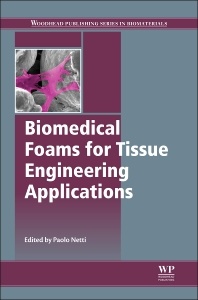Biomedical Foams for Tissue Engineering Applications Woodhead Publishing Series in Biomaterials Series
Coordonnateur : Netti Paolo

Biomedical foams are a new class of materials, which are increasingly being used for tissue engineering applications. Biomedical Foams for Tissue Engineering Applications provides a comprehensive review of this new class of materials, whose structure can be engineered to meet the requirements of nutrient trafficking and cell and tissue invasion, and to tune the degradation rate and mechanical stability on the specific tissue to be repaired.
Part one explores the fundamentals, properties, and modification of biomedical foams, including the optimal design and manufacture of biomedical foam pore structure for tissue engineering applications, biodegradable biomedical foam scaffolds, tailoring the pore structure of foam scaffolds for nerve regeneration, and tailoring properties of polymeric biomedical foams. Chapters in part two focus on tissue engineering applications of biomedical foams, including the use of bioactive glass foams for tissue engineering applications, bioactive glass and glass-ceramic foam scaffolds for bone tissue restoration, composite biomedical foams for engineering bone tissue, injectable biomedical foams for bone regeneration, polylactic acid (PLA) biomedical foams for tissue engineering, porous hydrogel biomedical foam scaffolds for tissue repair, and titanium biomedical foams for osseointegration.
Biomedical Foams for Tissue Engineering Applications is a technical resource for researchers and developers in the field of biomaterials, and academics and students of biomedical engineering and regenerative medicine.
Contributor contact details
Woodhead Publishing Series in Biomaterials
Part I: Fundamentals, properties and modification of biomedical foams
1. Introduction to biomedical foams
Abstract:
1.1 Introduction
1.2 Evolution of biomedical foams
1.3 Materials for fabricating biomedical foams
1.4 Manufacturing processes for biomedical foams and scaffolds
1.5 Scaffolds for in vitro cell culture
1.6 Scaffolds for in vivo tissue-induced regeneration
1.7 Platforms for the controlled delivery of bioactive agents
1.8 Microscaffolds for in situ cell delivery and tissue fabrication
1.9 Three-dimensional tumour models
1.10 Conclusion
1.11 References
2. Properties of biomedical foams for tissue engineering applications
Abstract:
2.1 Introduction
2.2 Metals for biomedical foam fabrication
2.3 Ceramics and glass for biomedical foam fabrication
2.4 Degradable polymers for biomedical foam fabrication
2.5 Polymer-based composites for biomedical foam fabrication
2.6 Conclusions and future trends
2.7 References
3. Optimal design and manufacture of biomedical foam pore structure for tissue engineering applications
Abstract:
3.1 Introduction
3.2 Micro-structure of biomedical foams and processing techniques
3.3 Improving control of scaffold pore structure by combined approaches
3.4 Pore structure versus in vitro cell culture
3.5 Pore structure vs. in vivo new tissue regeneration
3.6 Conclusion
3.7 References
4. Tailoring the pore structure of foam scaffolds for nerve regeneration
Abstract:
4.1 Introduction
4.2 Materials for foam scaffold fabrication
4.3 Design and fabrication of foam scaffolds for nerve regeneration
4.4 Methods of assessing nerve regeneration and overview of porous scaffolds
4.5 Future trends
4.6 Conclusion
4.7 References
5. Tailoring properties of polymeric biomedical foams
Abstract:
5.1 Introduction
5.2 Aliphatic polyesters used for porous scaffold fabrication
5.3 Polyurethanes for biomedical foam production
5.4 Tyrosine-derived polymers
5.5 Processing techniques for fabricating porous scaffolds
5.6 Characterization of polymeric foams
5.7 In vitro and in vivo testing
5.8 Applications of polymeric foams in tissue engineering
5.9 Future trends
5.10 Sources of further information and advice
5.11 References
6. Biodegradable biomedical foam scaffolds
Abstract:
6.1 Introduction
6.2 Foaming techniques and properties of expanding polymer/gas solutions
6.3 Biofoams based on natural polymers
6.4 Biofoams based on biodegradable polyesters
6.5 References
Part II: Tissue engineering applications of biomedical foams
7. Bioactive glass foams for tissue engineering applications
Abstract:
7.1 Introduction
7.2 Processing ‘foam-like’ bioactive glass-based scaffolds
7.3 In vitro and in vivo studies of bioactive glass-based biomedical foams
7.4 Conclusions and future trends
7.5 References
8. Bioactive glass and glass–ceramic foam scaffolds for bone tissue restoration
Abstract:
8.1 Introduction
8.2 The potential of bioactive glass and the bioactivity mechanism
8.3 Processing, 3-D architecture and mechanical properties of glass foams
8.4 In vitro and in vivo behaviour
8.5 Current clinical applications
8.6 Future trends
8.7 References
9. Composite biomedical foams for engineering bone tissue
Abstract:
9.1 Introduction
9.2 Chemical and morphological biomimesis: the key for osteointegration
9.3 Foaming: an approach to fabricate highly porous bioactive scaffolds
9.4 Freeze-dried hybrid gels for bone and osteochondral regeneration
9.5 In vivo performances of bioactive foams with defined morphology and microstructure
9.6 Future trends
9.7 Conclusion
9.8 References
10. Injectable biomedical foams for bone regeneration
Abstract:
10.1 Introduction
10.2 Injectable calcium phosphate foams
10.3 Porosity and mechanical performance of calcium phosphate foams
10.4 Injectability and cohesion of calcium phosphate foams
10.5 In vitro and in vivo response to injectable calcium phosphate foams
10.6 Applications of injectable calcium phosphate foams
10.7 Conclusion and future trends
10.8 Sources of further information and advice
10.9 Acknowledgments
10.10 References
11. Polylactic acid (PLA) biomedical foams for tissue engineering
Abstract:
11.1 Introduction
11.2 Polylactic acid (PLA)
11.3 Fabrication of PLA foams
11.4 Gas foaming using supercritical CO2 (scCO2)
11.5 Solid-state foaming with high pressure CO2
11.6 Tissue engineering applications of PLA and PLA-based foams
11.7 Conclusion and future trends
11.8 References
12. Porous hydrogel biomedical foam scaffolds for tissue repair
Abstract:
12.1 Introduction
12.2 Hydrogel foam materials
12.3 Equilibrium swelling theory and rubber elasticity theory
12.4 Overview of hydrogel properties
12.5 Natural hydrogel materials
12.6 Hydrogel foam processing technologies
12.7 Electrospinning and rapid prototyping
12.8 Characterization of hydrogel foams
12.9 Future trends
12.10 References
13. Titanium biomedical foams for osseointegration
Abstract:
13.1 Introduction: Titanium for biomedical applications
13.2 Titanium foam processing and surface treatments
13.3 Bio-activation of titanium surfaces
13.4 Bone interactions at the bio-interface
13.5 Future trends
13.6 Sources of further information and advice
13.7 References
Index
- Explores the fundamentals, properties, and modification of biomedical foams
- Includes intense focus on tissue engineering applications of biomedical foams
- A technical resource for researchers and developers in the field of biomaterials, and academics and students of biomedical engineering and regenerative medicine
Date de parution : 10-2018
Ouvrage de 446 p.
15.5x23.2 cm
Publication abandonnée
Date de parution : 02-2014
Ouvrage de 446 p.
15.5x23.2 cm
Épuisé



